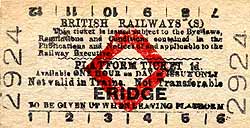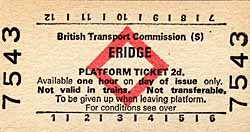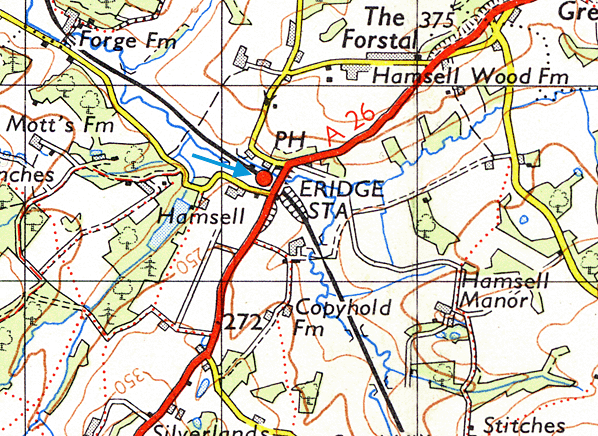
Station Name: ERIDGE
|
| Date opened: | 3.8.1868 |
| Location: | On the west side of an unnamed minor road off A26 |
| Company on opening: | London Brighton & South Coast Railway |
| Date closed to passengers: | Still open |
| Date closed completely: | Still open |
| Company on closing: | Still open |
| Present state: | Although still open only one of the four platform faces is still in use. The station consisted of two island platforms, the two outer platform faces were for the Eastbourne and Tunbridge Wells West trains. The track has been lifted on the Eastbourne platform but on the Tunbridge Wells platform the rusty track is still in situ although the junction to the north of the station has been severed. The platform buildings are somewhat dilapidated but still all intact and those on the down side have recently been repainted. An Eridge 'target' sign has also been mounted on this platform; this is a replica which was made by one of the members of the (TWERPS )Spa Valley Railway. The signal box to the north of the station is disused and boarded up. An unusual and still surviving feature is a mailbag chute under the up platform staircase. |
| County: | Sussex |
| OS Grid Ref: | TQ542346 |
| Date of visit: | 14.11.2005 |
|
Notes: Eridge station prospered over the years with trains leaving in four directions, to Lewes via Uckfield, to Polegate via Hailsham, to Tunbridge Wells via Groombridge and direct to Oxted and was expanded to provide two through platforms and two bay platforms plus goods facilities. Quite a lot of splitting and joining of trains took part with Brighton - London trains conveying a portion for Tunbridge Wells West, to be detached at Eridge and attached to an Eastbourne - Tunbridge Wells West service, whilst a portion from the Eastbourne - Tunbridge Wells West service would be detached and attached to the Brighton - London train, with the opposite happening with down services. The route from Brighton to London via Eridge was known colloquially by the drivers as the 'Outer Circle' with the comparable 'Inner Circle' being Brighton to London via Horsted Keynes. Between the two World Wars there was also a service from Brighton
to Maidstone, which was cut back to Brighton - Tonbridge by
the 1960's. Then during that decade the era of decline set in,
although in 1964 a new regular interval timetable for the Uckfield
line trains, by then dieselized, speeded up services - though
most terminated at Lewes rather than running through to Brighton.
(Above text from Southern
E Group web site) BRIEF HISTORY OF THE LEWES
- TUNBRIDGE WELLS WEST LINE Initially, nothing was done until after the completion of the Brighton - Hastings Line in 1846. In the mid 1850's the independent Lewes and Uckfield Railway Co. was incorporated and on 27th July 1856 they obtained an Act to build the branch line.
The line to Uckfield opened from Uckfield Junction on the 18th October 1858, 7 1/2 miles up the Ouse valley to Uckfield and within a year the LBSCR took over the independent company. For the first ten years the track ran from a junction off the line to Wivelsfield which had opened earlier in 1847. But this meant trains had to reverse at Lewes en route to Brighton and a new track was built in 1868 giving access to Lewes from the east. With the line pointing towards Tunbridge Wells the LBSCR were anxious to close the gap in their network and gave their support to the Brighton, Uckfield and Tunbridge Wells Company which was incorporated in 1861. Its 12 mile single track line opened on 3rd August 1868 from an end on junction at Uckfield to join the recently opened extension from East Grinstead - Tunbridge Wells at Groombridge Junction. The company was taken over by the LBSCR before the line opened. This was a further part of the Brighton Company's strategy to consolidate the area against competition from the South Eastern. When a further line was opened from Polegate to Eridge south of Groombridge Junction in 1880 the LBSCR had achieved its objective. In 1878 powers were obtained for a 1 mile long spur between Ashurst Junction on the East Grinstead - Groombridge Line and Birchden Junction, 1 mile north of Eridge on the Uckfield line. This enabled Groombridge to be bypassed without a reversal there. It remained largely unused until the final piece of the jigsaw was put into place with the opening of the Oxted & Groombridge Railway's line from Hurst Green Junction south of Oxted to Ashurst Junction. The local company was incorporated in 1861 and taken over by the LBSCR in 1864 four years before the line opened in 1888.
After WW2 commuters and local passengers were on the increase, encouraged by a frequent service and competitive fares but by the 1960's the Beeching era had begun and in 1964 new timetables were introduced making travel difficult with long waits for connections, by now a common ploy to reduce the number of passengers. The railway board wanted to close the line south of Hurst Green Junction to Lewes, together with the branch to Tunbridge Wells West. This met with vigorous opposition from local authorities and private individuals. Eventually the Minister gave way and agreed closure between Uckfield and Lewes only and the date was fixed for 6th January 1969. Bickering followed and the licensing of replacement buses was deferred. The railways board then said the viaduct across the River Ouse was safe only on one line and a shuttle service was introduced. This did not fit in with trains north of Uckfield and traffic dropped still further. Eventually railway engineers insisted the viaduct should be completely closed. The railways then hired buses for a time and Barcombe Mills and Isfield stayed open to issue tickets. The buses could not negotiate the narrow winding road to Barcombe Mills, so the railways provided a taxi to take passengers from the railway station to the bus stop. But this was only after intending passengers had walked over a mile to the station to buy their tickets!
This line has now been restored and reopened as the Spa
Valley Railway. Isfield station has now been restored to early Southern Railway
colours and looks very much as it would have done in the 1920's
and 30's. The track has been extensively overhauled and modified
since the society took over and the line has recently been extended
to one mile operating a steam service as the Lavender
Line, named after A E Lavender and Sons the coal merchants
which used to operate from Isfield station yard. The Wealden Line Campaign was launched in 1986 to fight for the full restoration of the train services between Lewes and Tunbridge Wells A blow to their campaign came in 1991 when Uckfield Station
was resited to the north side of the level crossing. Initially
the old station and route to the bypass was preserved in case
it should be required for a future restoration of passenger
service. Initially the local authority were enthusiastic about
the restoration of the rail service between Uckfield and Lewes
but in 1998 they decided that a land use policy to restrict
development around the former route could not be justified.
The campaign continues. To see the other
stations on the Eastbourne - Tunbridge Wells West line click
on the station name: Barcombe
Mills, Isfield,
Uckfield, Buxted,
|
2.jpg)
 Home
Page
Home
Page
| Last updated: Thursday, 18-May-2017 11:16:36 CEST |
© 1998-2007 Disused Stations
|






